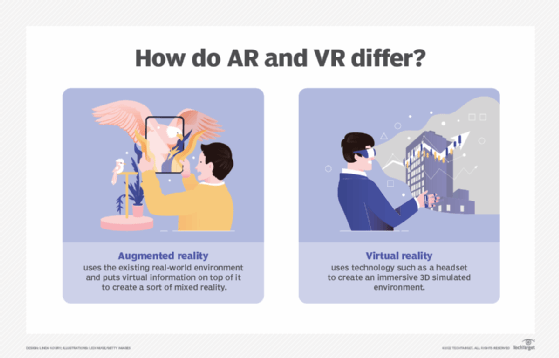Top 5 use cases for 5G augmented and virtual reality
By integrating augmented and virtual reality technologies with 5G, several industries could reap significant benefits. But beware of some important limitations.
5G is rapidly becoming the default technology for cellular wireless networks. New variants of 5G even offer the opportunity to replace wired WANs. As 5G availability continues to grow, so do the opportunities to use its high bandwidth and low latency for new and exciting use cases.
One area of increasing interest is 5G's support for augmented reality (AR) and virtual reality (VR). Let's explore five ways that AR and VR can use 5G.
1. Customer service and support
Today, most customer engagement consists of calls or text messages with contact center agents. By using 5G's speed, along with AR and VR applications on mobile devices, companies can provide customers with real-time guidance.
For example, a customer trying to assemble a complex piece of equipment could get live help, via AR, that overlays specific instructions on top of what the customer is seeing. In this scenario, a product expert can guide the customer toward completing necessary steps.
Another possibility is using AR for product demonstrations. For example, customers could see what they look like in clothes before they buy them. Or they could see how a paint color would look before applying it. Anyone looking to remodel a kitchen could see an overlay of the final design on top of their current kitchen.
Additionally, sales personnel could walk someone through all aspects of a product before purchase. Imagine taking a guided VR tour of a new vehicle, including the interior and its features, without having to visit a showroom.
In all cases, combining the right hardware with 5G technologies opens possibilities to improve the customer experience and sales activities.

2. Healthcare
The healthcare industry has many options to use AR and VR over 5G. In a training scenario, instructors can use VR to demonstrate a new procedure or technique to medical students, doctors and nurses remotely, wherever they are, thus saving on travel costs. Instructors can use AR on top of live procedures to point out steps and points of interest. Or they can use VR to bring remote participants into an operating or examination room, enabling them to observe and ask questions.
From the patient perspective, AR and VR over 5G offer opportunities to enhance telemedicine, providing healthcare professionals with the ability to conduct remote examinations, highlight areas of concern to patients and even walk patients through procedures before their appointments.
5G-enabled AR and VR devices, such as wearable glasses, can enable medical care professionals to include remote experts directly in the examination room, potentially saving time, costs and, ultimately, lives. Consider, for example, surgeons who run into a problem during a procedure. Using a 5G-enabled wearable device, they can easily show a remote specialist what they are seeing. Using AR, the specialist can guide the local provider during the procedure.
3. Meetings and the employee experience
AR and VR meetings have been under development for many years. But, so far, these scenarios have failed to achieve critical mass due to poor UX and high bandwidth needs. 5G can address these issues by bringing high-quality, high-bandwidth network services to remote participants.
One likely area of growth is for virtual conferences and training sessions. In these cases, AR and VR technologies can support a higher quality, more engaged experience for remote participants versus simply viewing content on a 2D screen. Virtual meeting rooms could enable attendees to see 3D presentations, meet one another via avatars and closely inspect virtual representations of physical items.
In this example, 5G enables VR access via mobile device, regardless of attendee location.
4. Training and education
AR and VR over 5G offer the potential to deliver high-quality immersive education and training to remote participants anywhere in the world. Teaching scenarios that today require in-person instruction, such as lab experiments, could be done using VR and AR, making education more accessible and less costly.
The cost of training field personnel on new products and techniques can be reduced by eliminating the need to bring field workers to in-person training classes or dispatch trainers to conduct in-person training in the field. The use of AR and VR over 5G for training is especially attractive to industries operating in remote locations, such as mines, drilling sites and other areas, that lack access to high-speed wired network services.
5. Construction
The potential of AR and VR over 5G to support construction use cases encapsulates many of the previously discussed scenarios.
From a design perspective, architects and engineers can share plans with on-site personnel via AR that overlays blueprints on top of live images of a construction site. A VR experience could show builders what the finished site would look like, enabling them to visualize what they're building toward. And on-site construction personnel could use VR and AR to work with remote designers to address issues that arise or to work through potential change requests without the need for in-person consultations.
5G AR and VR limitations
Despite the numerous potential benefits from using AR and VR over 5G, limitations do exist. The biggest limitation is the availability of 5G and higher-speed 5G variants, especially in remote areas.
BroadbandNow, a data aggregation company, estimated that 62% of households in the U.S. have access to 5G. This may necessitate the construction of private 5G networks for some of the outlined use cases, such as construction sites.
5G availability may even be limited in urban areas, especially within buildings. And available bandwidth is likely to be limited by the number of 5G users at any given time who are all contending for network resources. 5G AR and VR applications are likely to be constrained by the processing power available within mobile devices and battery life.
AR and VR over 5G offer significant potential to deliver new and innovative capabilities to customers and employees and reduce the costs of training and customer service. A proactive approach is required to identify applicable use cases for any organization.
Irwin Lazar is president and principal analyst at Metrigy, where he leads coverage on the digital workplace. His research focus includes unified communications, VoIP, video conferencing and team collaboration.








